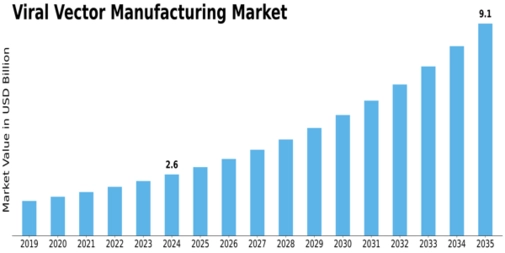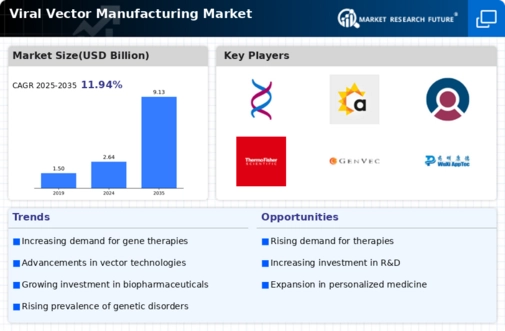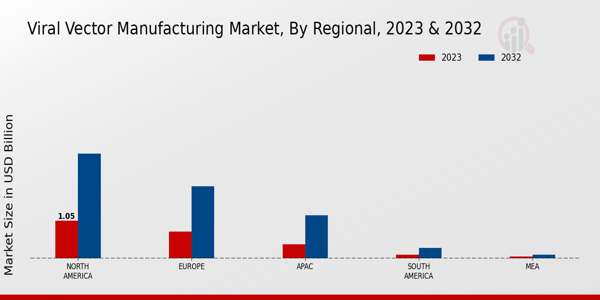-
EXECUTIVE SUMMARY
-
Key Findings
-
Market Segmentation
-
Challenges and Opportunities
-
Future
-
MARKET INTRODUCTION
-
Definition
-
Scope of the study
- Research Objective
- Assumption
- Limitations
-
RESEARCH METHODOLOGY
-
Overview
-
Secondary Research
-
Primary Research
- Breakdown of Primary
-
Forecasting Model
-
Market Size Estimation
- Top-Down Approach
-
Data Triangulation
-
Validation
-
MARKET DYNAMICS
-
Overview
-
Drivers
-
Restraints
-
Opportunities
-
MARKET
-
Value chain Analysis
-
Porter's Five Forces
- Bargaining Power of Suppliers
- Bargaining Power
- Threat of New Entrants
- Threat of Substitutes
- Intensity of Rivalry
-
COVID-19 Impact Analysis
- Regional Impact
- Opportunity and
-
VIRAL VECTOR MANUFACTURING MARKET, BY
-
Gene Therapy
-
Vaccines
-
Cardiovascular Diseases
-
VIRAL VECTOR MANUFACTURING
-
Adenoviral Vectors
-
Adeno-Associated
-
Lentiviral Vectors
-
Retroviral Vectors
-
Pharmaceutical
-
Research Institutions
-
Biotechnology Companies
-
VIRAL VECTOR MANUFACTURING MARKET, BY VECTOR DESIGN (USD BILLION)
-
Single-Stranded
-
Double-Stranded
-
North America
- US
- Canada
-
Europe
- Germany
- UK
- France
- Russia
- Italy
- Rest of Europe
-
APAC
- China
- Japan
- South Korea
- Malaysia
- Indonesia
- Rest of APAC
-
South America
- Brazil
- Mexico
- Argentina
-
MEA
- GCC Countries
- Rest of MEA
-
COMPETITIVE LANDSCAPE
-
Overview
-
Competitive Analysis
-
Market share Analysis
-
Major Growth Strategy in the Viral Vector Manufacturing Market
-
Leading Players in Terms of Number of Developments
-
Key developments and growth
- New Product Launch/Service Deployment
- Merger
- Joint Ventures
-
Major Players Financial
- Sales and Operating Income
- Major Players R&D
-
COMPANY PROFILES
-
Oxford Biomedica
- Products Offered
- Key Developments
- SWOT Analysis
- Key Strategies
-
Aldevron
- Financial Overview
- Products Offered
- Key Developments
- SWOT Analysis
- Key Strategies
-
Sangamo Therapeutics
- Financial Overview
- Products Offered
- Key
- SWOT Analysis
- Key Strategies
- Financial Overview
- Products
- Key Developments
- SWOT Analysis
-
GenVec
- Financial Overview
- Key Developments
- SWOT Analysis
- Key Strategies
-
Viralgen VectorCore
- Financial
- Products Offered
- Key Developments
- Key Strategies
-
Adenovirus Center
- Products Offered
- Key Developments
- SWOT Analysis
- Key Strategies
-
Wuxi AppTec
- Financial Overview
- Products Offered
- Key
- SWOT Analysis
- Key Strategies
- Financial Overview
- Products Offered
- Key Developments
- SWOT Analysis
- Key Strategies
-
VivaZome Therapeutics
- Financial Overview
- Key Developments
- SWOT Analysis
- Key Strategies
-
Lonza
- Financial Overview
- Products Offered
- Key Developments
- SWOT
- Key Strategies
-
MaxCyte
- Financial
- Products Offered
- Key Developments
- Key Strategies
-
Fujifilm Diosynth Biotechnologies
- Financial Overview
- Products Offered
- SWOT Analysis
- Key Strategies
-
Charles River Laboratories
- Financial Overview
- Key Developments
- SWOT Analysis
- Key Strategies
-
SIRION Biotech
- Financial Overview
- Products Offered
- Key Developments
- SWOT
- Key Strategies
-
APPENDIX
-
References
-
Related Reports
-
LIST OF ASSUMPTIONS
-
NORTH AMERICA VIRAL VECTOR MANUFACTURING MARKET SIZE ESTIMATES &
-
NORTH AMERICA
-
NORTH AMERICA VIRAL VECTOR MANUFACTURING MARKET SIZE
-
NORTH
-
NORTH AMERICA VIRAL VECTOR MANUFACTURING
-
US VIRAL VECTOR MANUFACTURING MARKET SIZE ESTIMATES & FORECAST, BY
-
US VIRAL VECTOR MANUFACTURING
-
US VIRAL VECTOR MANUFACTURING MARKET SIZE ESTIMATES & FORECAST, BY END USE,
-
US VIRAL VECTOR MANUFACTURING MARKET SIZE
-
US VIRAL VECTOR MANUFACTURING MARKET SIZE ESTIMATES & FORECAST, BY REGIONAL,
-
CANADA VIRAL VECTOR MANUFACTURING MARKET
-
CANADA VIRAL VECTOR MANUFACTURING MARKET SIZE ESTIMATES & FORECAST, BY TYPE,
-
CANADA VIRAL VECTOR MANUFACTURING MARKET
-
CANADA VIRAL VECTOR MANUFACTURING MARKET SIZE ESTIMATES & FORECAST, BY VECTOR
-
CANADA VIRAL VECTOR MANUFACTURING
-
EUROPE VIRAL VECTOR MANUFACTURING MARKET SIZE ESTIMATES & FORECAST,
-
EUROPE VIRAL VECTOR MANUFACTURING
-
EUROPE VIRAL VECTOR MANUFACTURING MARKET SIZE ESTIMATES & FORECAST, BY END
-
EUROPE VIRAL VECTOR MANUFACTURING
-
EUROPE VIRAL VECTOR MANUFACTURING MARKET SIZE ESTIMATES & FORECAST,
-
GERMANY VIRAL VECTOR MANUFACTURING
-
GERMANY VIRAL VECTOR MANUFACTURING MARKET SIZE ESTIMATES & FORECAST,
-
GERMANY VIRAL VECTOR MANUFACTURING
-
GERMANY VIRAL VECTOR MANUFACTURING MARKET SIZE ESTIMATES & FORECAST, BY
-
GERMANY VIRAL VECTOR MANUFACTURING
-
UK VIRAL VECTOR MANUFACTURING MARKET SIZE ESTIMATES & FORECAST,
-
UK VIRAL VECTOR MANUFACTURING
-
UK VIRAL VECTOR MANUFACTURING MARKET SIZE ESTIMATES & FORECAST, BY END USE,
-
UK VIRAL VECTOR MANUFACTURING MARKET SIZE
-
UK VIRAL VECTOR MANUFACTURING MARKET SIZE ESTIMATES & FORECAST, BY REGIONAL,
-
FRANCE VIRAL VECTOR MANUFACTURING MARKET
-
FRANCE VIRAL VECTOR MANUFACTURING MARKET SIZE ESTIMATES & FORECAST, BY TYPE,
-
FRANCE VIRAL VECTOR MANUFACTURING MARKET
-
FRANCE VIRAL VECTOR MANUFACTURING MARKET SIZE ESTIMATES & FORECAST, BY VECTOR
-
FRANCE VIRAL VECTOR MANUFACTURING
-
RUSSIA VIRAL VECTOR MANUFACTURING MARKET SIZE ESTIMATES & FORECAST,
-
RUSSIA VIRAL VECTOR MANUFACTURING
-
RUSSIA VIRAL VECTOR MANUFACTURING MARKET SIZE ESTIMATES & FORECAST, BY END
-
RUSSIA VIRAL VECTOR MANUFACTURING
-
RUSSIA VIRAL VECTOR MANUFACTURING MARKET SIZE ESTIMATES & FORECAST,
-
ITALY VIRAL VECTOR MANUFACTURING
-
ITALY VIRAL VECTOR MANUFACTURING MARKET SIZE ESTIMATES & FORECAST,
-
ITALY VIRAL VECTOR MANUFACTURING
-
ITALY VIRAL VECTOR MANUFACTURING MARKET SIZE ESTIMATES & FORECAST, BY VECTOR
-
ITALY VIRAL VECTOR MANUFACTURING
-
SPAIN VIRAL VECTOR MANUFACTURING MARKET SIZE ESTIMATES & FORECAST,
-
SPAIN VIRAL VECTOR MANUFACTURING
-
SPAIN VIRAL VECTOR MANUFACTURING MARKET SIZE ESTIMATES & FORECAST, BY END
-
SPAIN VIRAL VECTOR MANUFACTURING MARKET
-
SPAIN VIRAL VECTOR MANUFACTURING MARKET SIZE ESTIMATES & FORECAST, BY REGIONAL,
-
REST OF EUROPE VIRAL VECTOR MANUFACTURING
-
REST OF EUROPE VIRAL VECTOR MANUFACTURING MARKET SIZE ESTIMATES &
-
REST OF EUROPE VIRAL
-
REST OF EUROPE VIRAL VECTOR MANUFACTURING MARKET
-
REST OF EUROPE VIRAL VECTOR MANUFACTURING MARKET SIZE ESTIMATES & FORECAST,
-
APAC VIRAL VECTOR MANUFACTURING
-
APAC VIRAL VECTOR MANUFACTURING MARKET SIZE ESTIMATES & FORECAST,
-
APAC VIRAL VECTOR MANUFACTURING
-
APAC VIRAL VECTOR MANUFACTURING MARKET SIZE ESTIMATES & FORECAST, BY VECTOR
-
APAC VIRAL VECTOR MANUFACTURING
-
CHINA VIRAL VECTOR MANUFACTURING MARKET SIZE ESTIMATES & FORECAST,
-
CHINA VIRAL VECTOR MANUFACTURING
-
CHINA VIRAL VECTOR MANUFACTURING MARKET SIZE ESTIMATES & FORECAST, BY END
-
CHINA VIRAL VECTOR MANUFACTURING MARKET
-
CHINA VIRAL VECTOR MANUFACTURING MARKET SIZE ESTIMATES & FORECAST, BY REGIONAL,
-
INDIA VIRAL VECTOR MANUFACTURING MARKET
-
INDIA VIRAL VECTOR MANUFACTURING MARKET SIZE ESTIMATES & FORECAST, BY TYPE,
-
INDIA VIRAL VECTOR MANUFACTURING MARKET
-
INDIA VIRAL VECTOR MANUFACTURING MARKET SIZE ESTIMATES & FORECAST, BY VECTOR
-
INDIA VIRAL VECTOR MANUFACTURING
-
JAPAN VIRAL VECTOR MANUFACTURING MARKET SIZE ESTIMATES & FORECAST,
-
JAPAN VIRAL VECTOR MANUFACTURING
-
JAPAN VIRAL VECTOR MANUFACTURING MARKET SIZE ESTIMATES & FORECAST, BY END
-
JAPAN VIRAL VECTOR MANUFACTURING MARKET
-
JAPAN VIRAL VECTOR MANUFACTURING MARKET SIZE ESTIMATES & FORECAST, BY REGIONAL,
-
SOUTH KOREA VIRAL VECTOR MANUFACTURING
-
SOUTH KOREA VIRAL VECTOR MANUFACTURING MARKET SIZE ESTIMATES & FORECAST,
-
SOUTH KOREA VIRAL VECTOR MANUFACTURING
-
SOUTH KOREA VIRAL VECTOR MANUFACTURING MARKET SIZE ESTIMATES & FORECAST,
-
SOUTH KOREA VIRAL VECTOR
-
MALAYSIA VIRAL VECTOR MANUFACTURING MARKET SIZE ESTIMATES
-
MALAYSIA
-
MALAYSIA VIRAL VECTOR MANUFACTURING MARKET SIZE ESTIMATES
-
MALAYSIA VIRAL
-
MALAYSIA VIRAL VECTOR MANUFACTURING MARKET SIZE ESTIMATES
-
THAILAND VIRAL
-
THAILAND VIRAL VECTOR MANUFACTURING MARKET SIZE ESTIMATES
-
THAILAND VIRAL
-
THAILAND VIRAL VECTOR MANUFACTURING MARKET SIZE ESTIMATES
-
THAILAND
-
INDONESIA VIRAL VECTOR MANUFACTURING MARKET SIZE
-
INDONESIA VIRAL VECTOR MANUFACTURING MARKET
-
INDONESIA VIRAL VECTOR MANUFACTURING MARKET SIZE ESTIMATES & FORECAST, BY
-
INDONESIA VIRAL VECTOR MANUFACTURING
-
REST OF APAC VIRAL VECTOR MANUFACTURING MARKET SIZE ESTIMATES &
-
REST OF APAC
-
REST OF APAC VIRAL VECTOR MANUFACTURING MARKET SIZE
-
REST OF APAC VIRAL VECTOR
-
SOUTH AMERICA VIRAL VECTOR MANUFACTURING MARKET SIZE
-
SOUTH AMERICA VIRAL VECTOR MANUFACTURING
-
SOUTH AMERICA VIRAL VECTOR MANUFACTURING MARKET SIZE ESTIMATES & FORECAST,
-
SOUTH AMERICA VIRAL
-
BRAZIL VIRAL VECTOR MANUFACTURING MARKET SIZE ESTIMATES
-
BRAZIL
-
BRAZIL VIRAL VECTOR MANUFACTURING MARKET SIZE ESTIMATES
-
BRAZIL VIRAL
-
BRAZIL VIRAL VECTOR MANUFACTURING MARKET SIZE ESTIMATES
-
MEXICO VIRAL
-
MEXICO VIRAL VECTOR MANUFACTURING MARKET SIZE ESTIMATES
-
MEXICO VIRAL
-
MEXICO VIRAL VECTOR MANUFACTURING MARKET SIZE ESTIMATES
-
MEXICO
-
ARGENTINA VIRAL VECTOR MANUFACTURING MARKET SIZE
-
ARGENTINA VIRAL VECTOR MANUFACTURING MARKET
-
ARGENTINA VIRAL VECTOR MANUFACTURING MARKET SIZE ESTIMATES & FORECAST,
-
ARGENTINA VIRAL VECTOR
-
REST OF SOUTH AMERICA VIRAL VECTOR MANUFACTURING MARKET
-
REST OF SOUTH AMERICA VIRAL VECTOR MANUFACTURING MARKET SIZE ESTIMATES &
-
REST OF SOUTH AMERICA
-
REST OF SOUTH AMERICA VIRAL VECTOR MANUFACTURING
-
REST OF SOUTH AMERICA VIRAL VECTOR MANUFACTURING MARKET SIZE ESTIMATES
-
MEA VIRAL
-
MEA VIRAL VECTOR MANUFACTURING MARKET SIZE ESTIMATES
-
MEA VIRAL VECTOR
-
MEA VIRAL VECTOR MANUFACTURING MARKET SIZE ESTIMATES & FORECAST,
-
MEA VIRAL VECTOR MANUFACTURING
-
GCC COUNTRIES VIRAL VECTOR MANUFACTURING MARKET SIZE ESTIMATES &
-
GCC COUNTRIES
-
GCC COUNTRIES VIRAL VECTOR MANUFACTURING MARKET
-
GCC COUNTRIES VIRAL VECTOR MANUFACTURING MARKET SIZE ESTIMATES & FORECAST,
-
GCC COUNTRIES VIRAL
-
SOUTH AFRICA VIRAL VECTOR MANUFACTURING MARKET SIZE
-
SOUTH AFRICA VIRAL VECTOR MANUFACTURING
-
SOUTH AFRICA VIRAL VECTOR MANUFACTURING MARKET SIZE ESTIMATES & FORECAST,
-
SOUTH AFRICA VIRAL VECTOR
-
REST OF MEA VIRAL VECTOR MANUFACTURING MARKET SIZE ESTIMATES
-
REST OF
-
REST OF MEA VIRAL VECTOR MANUFACTURING MARKET SIZE
-
REST OF MEA VIRAL VECTOR
-
PRODUCT LAUNCH/PRODUCT DEVELOPMENT/APPROVAL
-
ACQUISITION/PARTNERSHIP
-
NORTH AMERICA VIRAL VECTOR MANUFACTURING MARKET
-
US VIRAL VECTOR MANUFACTURING MARKET ANALYSIS BY APPLICATION
-
US VIRAL VECTOR MANUFACTURING MARKET ANALYSIS BY TYPE
-
US VIRAL VECTOR MANUFACTURING MARKET ANALYSIS BY END USE
-
US VIRAL
-
US VIRAL VECTOR
-
CANADA VIRAL VECTOR MANUFACTURING
-
CANADA VIRAL VECTOR MANUFACTURING
-
CANADA VIRAL VECTOR MANUFACTURING MARKET
-
CANADA VIRAL VECTOR MANUFACTURING MARKET ANALYSIS
-
CANADA VIRAL VECTOR MANUFACTURING MARKET ANALYSIS
-
EUROPE VIRAL VECTOR MANUFACTURING MARKET ANALYSIS
-
GERMANY VIRAL VECTOR MANUFACTURING MARKET ANALYSIS BY APPLICATION
-
GERMANY VIRAL VECTOR MANUFACTURING MARKET ANALYSIS BY TYPE
-
GERMANY VIRAL VECTOR MANUFACTURING MARKET ANALYSIS BY END USE
-
GERMANY VIRAL VECTOR MANUFACTURING MARKET ANALYSIS BY REGIONAL
-
UK VIRAL VECTOR MANUFACTURING MARKET ANALYSIS BY APPLICATION
-
UK VIRAL
-
UK VIRAL VECTOR
-
UK VIRAL VECTOR
-
FRANCE VIRAL VECTOR MANUFACTURING
-
FRANCE VIRAL VECTOR MANUFACTURING
-
FRANCE VIRAL VECTOR MANUFACTURING MARKET
-
FRANCE VIRAL VECTOR MANUFACTURING MARKET ANALYSIS
-
FRANCE VIRAL VECTOR MANUFACTURING MARKET ANALYSIS
-
RUSSIA VIRAL VECTOR MANUFACTURING MARKET ANALYSIS BY
-
RUSSIA VIRAL VECTOR MANUFACTURING MARKET ANALYSIS BY
-
RUSSIA VIRAL VECTOR MANUFACTURING MARKET ANALYSIS BY END USE
-
RUSSIA VIRAL VECTOR MANUFACTURING MARKET ANALYSIS BY VECTOR DESIGN
-
RUSSIA VIRAL VECTOR MANUFACTURING MARKET ANALYSIS BY REGIONAL
-
ITALY VIRAL VECTOR MANUFACTURING MARKET ANALYSIS BY APPLICATION
-
ITALY VIRAL VECTOR MANUFACTURING MARKET ANALYSIS BY TYPE
-
ITALY VIRAL VECTOR MANUFACTURING MARKET ANALYSIS BY END USE
-
SPAIN
-
SPAIN
-
SPAIN VIRAL
-
SPAIN VIRAL VECTOR
-
SPAIN VIRAL VECTOR
-
REST OF EUROPE VIRAL
-
REST OF EUROPE
-
REST OF EUROPE
-
REST OF EUROPE
-
REST
-
CHINA VIRAL VECTOR
-
CHINA VIRAL VECTOR
-
CHINA VIRAL VECTOR MANUFACTURING
-
CHINA VIRAL VECTOR MANUFACTURING MARKET
-
CHINA VIRAL VECTOR MANUFACTURING MARKET
-
INDIA VIRAL VECTOR MANUFACTURING MARKET ANALYSIS
-
INDIA VIRAL VECTOR MANUFACTURING MARKET ANALYSIS
-
INDIA VIRAL VECTOR MANUFACTURING MARKET ANALYSIS BY END
-
INDIA VIRAL VECTOR MANUFACTURING MARKET ANALYSIS BY VECTOR
-
INDIA VIRAL VECTOR MANUFACTURING MARKET ANALYSIS BY REGIONAL
-
JAPAN VIRAL VECTOR MANUFACTURING MARKET ANALYSIS BY APPLICATION
-
JAPAN VIRAL VECTOR MANUFACTURING MARKET ANALYSIS BY TYPE
-
JAPAN VIRAL VECTOR MANUFACTURING MARKET ANALYSIS BY END USE
-
SOUTH
-
SOUTH KOREA VIRAL VECTOR MANUFACTURING MARKET ANALYSIS BY REGIONAL
-
MALAYSIA VIRAL VECTOR MANUFACTURING MARKET ANALYSIS BY APPLICATION
-
MALAYSIA VIRAL VECTOR MANUFACTURING MARKET ANALYSIS BY TYPE
-
MALAYSIA VIRAL VECTOR MANUFACTURING MARKET ANALYSIS BY REGIONAL
-
THAILAND VIRAL VECTOR MANUFACTURING MARKET ANALYSIS BY APPLICATION
-
THAILAND VIRAL VECTOR MANUFACTURING MARKET ANALYSIS BY TYPE
-
THAILAND VIRAL VECTOR MANUFACTURING MARKET ANALYSIS BY REGIONAL
-
INDONESIA VIRAL VECTOR MANUFACTURING MARKET ANALYSIS BY APPLICATION
-
INDONESIA VIRAL VECTOR MANUFACTURING MARKET ANALYSIS BY TYPE
-
INDONESIA VIRAL VECTOR MANUFACTURING MARKET ANALYSIS BY REGIONAL
-
REST OF APAC VIRAL VECTOR MANUFACTURING MARKET ANALYSIS BY APPLICATION
-
REST OF APAC VIRAL VECTOR MANUFACTURING MARKET ANALYSIS BY TYPE
-
REST OF APAC VIRAL VECTOR MANUFACTURING MARKET ANALYSIS BY END USE
-
REST OF APAC VIRAL VECTOR MANUFACTURING MARKET ANALYSIS BY VECTOR DESIGN
-
REST OF APAC VIRAL VECTOR MANUFACTURING MARKET ANALYSIS BY REGIONAL
-
SOUTH AMERICA VIRAL VECTOR MANUFACTURING MARKET ANALYSIS
-
BRAZIL VIRAL VECTOR MANUFACTURING MARKET ANALYSIS BY APPLICATION
-
BRAZIL VIRAL VECTOR MANUFACTURING MARKET ANALYSIS BY TYPE
-
BRAZIL
-
BRAZIL VIRAL
-
BRAZIL VIRAL
-
MEXICO VIRAL VECTOR
-
MEXICO VIRAL VECTOR
-
MEXICO VIRAL VECTOR MANUFACTURING
-
MEXICO VIRAL VECTOR MANUFACTURING MARKET
-
MEXICO VIRAL VECTOR MANUFACTURING MARKET
-
ARGENTINA VIRAL VECTOR MANUFACTURING MARKET
-
ARGENTINA VIRAL VECTOR MANUFACTURING MARKET
-
ARGENTINA VIRAL VECTOR MANUFACTURING MARKET ANALYSIS
-
ARGENTINA VIRAL VECTOR MANUFACTURING MARKET ANALYSIS
-
ARGENTINA VIRAL VECTOR MANUFACTURING MARKET ANALYSIS
-
REST OF SOUTH AMERICA VIRAL VECTOR MANUFACTURING MARKET
-
REST OF SOUTH AMERICA VIRAL VECTOR MANUFACTURING
-
REST OF SOUTH AMERICA VIRAL VECTOR MANUFACTURING
-
REST OF SOUTH AMERICA VIRAL VECTOR
-
REST OF SOUTH AMERICA
-
MEA VIRAL
-
GCC COUNTRIES VIRAL VECTOR
-
GCC COUNTRIES VIRAL
-
GCC COUNTRIES VIRAL
-
GCC COUNTRIES
-
GCC
-
SOUTH AFRICA VIRAL VECTOR MANUFACTURING MARKET ANALYSIS BY TYPE
-
SOUTH AFRICA VIRAL VECTOR MANUFACTURING MARKET ANALYSIS BY END USE
-
SOUTH AFRICA VIRAL VECTOR MANUFACTURING MARKET ANALYSIS BY VECTOR DESIGN
-
SOUTH AFRICA VIRAL VECTOR MANUFACTURING MARKET ANALYSIS BY REGIONAL
-
REST OF MEA VIRAL VECTOR MANUFACTURING MARKET ANALYSIS BY APPLICATION
-
REST OF MEA VIRAL VECTOR MANUFACTURING MARKET ANALYSIS BY TYPE
-
REST OF MEA VIRAL VECTOR MANUFACTURING MARKET ANALYSIS BY END
-
REST OF MEA VIRAL VECTOR MANUFACTURING MARKET ANALYSIS BY
-
REST OF MEA VIRAL VECTOR MANUFACTURING MARKET ANALYSIS
-
KEY BUYING CRITERIA OF VIRAL VECTOR MANUFACTURING
-
RESEARCH PROCESS OF MRFR
-
DRO ANALYSIS
-
DRIVERS IMPACT ANALYSIS:
-
RESTRAINTS IMPACT ANALYSIS:
-
SUPPLY / VALUE CHAIN: VIRAL
-
VIRAL VECTOR MANUFACTURING MARKET,
-
VIRAL VECTOR MANUFACTURING MARKET,
-
VIRAL VECTOR MANUFACTURING
-
VIRAL VECTOR MANUFACTURING MARKET,
-
VIRAL VECTOR MANUFACTURING
-
VIRAL VECTOR MANUFACTURING
-
VIRAL VECTOR MANUFACTURING
-
VIRAL VECTOR MANUFACTURING
-
VIRAL VECTOR
-
VIRAL VECTOR


















Leave a Comment